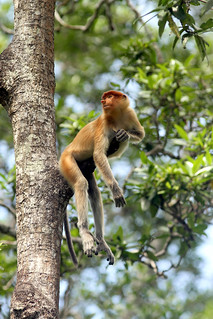Monkey Business in Borneo

Who are you calling ‘Big Nose’?
Keeping a harem of eager females pleased is a tough job for the top monkey. Roderick Eime takes notes.
“Oh, Janet, don’t look!” comes the cry from within our pack of transfixed voyeurs. Alas, some warnings just seem to have the opposite effect and instead of averting our gaze our eyes fall immediately upon this visual offence.
 The big male we called Alistair, in an obvious state of preparedness, quickly responds to the lascivious signals from the female and the rest requires no further description. We titter and feign prudery as the act continues while the rest of the troupe, including the jealous and similarly eager bachelors, looks on. That famous cult rock hit from ‘Nine Inch Nails’ somehow comes to mind.
The big male we called Alistair, in an obvious state of preparedness, quickly responds to the lascivious signals from the female and the rest requires no further description. We titter and feign prudery as the act continues while the rest of the troupe, including the jealous and similarly eager bachelors, looks on. That famous cult rock hit from ‘Nine Inch Nails’ somehow comes to mind.
Proboscis Monkeys (Nasalis larvatus) are a highly social, intelligent, arboreal (tree-dwelling) mammal endemic to Borneo. The name comes about, not from their ‘ever ready’ alertness, but from the distinctive nasal appendage. Locals once called them the Dutchman Monkey for their similarity to the bulbous red European nose.
The troupe, as we are quickly learning, is governed by a single dominant male whose job description is pretty straightforward – and the girls keep him up to the task as there is always another vigilant bloke ready to cut his grass.
Here at the Labuk Bay Sanctuary, it is hard to imagine a better place to observe these otherwise secretive and reclusive primates. The sanctuary came about almost by accident when local palm oil baron, Michael Lee, was engaged in the clear-felling of mangroves along the Kinabatangan River in eastern Sabah in 1994. Short of food from their quickly vanishing forest, the naughty proboscises started raiding workers’ huts with the predictable result. Hearing of this disruption on his plantation, Lee came over to see for himself. Instead of calling for the animals’ eradication, he set aside about 160 hectares of riparian (riverside) forest for the protection of this endangered species.
Such has been the success of the Labuk Bay Sanctuary that it is now a fixture on any serious nature lover’s itinerary and provides a much more dynamic spectacle (if you’ll excuse the understatement) than the nearby Sepilok Orang Utan Rehabilitation Centre where you watch a couple of dozy apes gorge themselves on bananas. Don’t get me wrong, Orang Utans are drop-dead gorgeous and the little ones impossibly cute, but the interaction is strictly managed and the international volunteer park wardens eagerly enforce the separation. Labuk Bay, by contrast, is a riotous frenzy as Alistair and his excited entourage swarm noisily across the viewing platform oblivious to the human obstruction.
 But before you think there is lots of tummy tickles and back-scratching, human contact with any primate, especially wild ones, is not a good idea.
But before you think there is lots of tummy tickles and back-scratching, human contact with any primate, especially wild ones, is not a good idea.
“Orang Utans share 97 per cent of human DNA and while proboscis monkeys share somewhat less, the transmission of mutually infectious disease is a distinct possibility,” says Orion expedition leader Mick Fogg putting on his stern face, “so as much as you are tempted, PLEASE don’t touch the monkeys.”
Mick has spent most of the last year of his life putting together Orion Expedition Cruises’ (OEC) inaugural Borneo itineraries and by the look of things, he’s done a pretty fair job for the many repeat passengers and his demanding governors. While there’s a heavy bias to natural attractions, there’s plenty of culture and history too.
Sarina Bratton, Australia’s doyenne of adventure cruising, added Orion II to the company’s portfolio in June of this year and after a technical refit and upgrading of cabins and public spaces, the 20-year-old vessel set off on an ambitious journey around the Pacific Rim, encountering earthquakes, volcanoes and typhoons en route.
“Orion II allows us to expand our adventures with a range of exciting luxury expeditions stretching from the Russian Far East to Antarctica,” said Ms Bratton at the launch event. Meanwhile the search for a future Orion III continues.
In her past lives, the 88m, 4000 ton Orion II was most recently known as Clelia II and was built as one of a fleet of eight small luxury ships for the now defunct Renaissance Cruises in 1991. With generously sized cabins and spacious public areas, her 100 guests enjoy a high crew-to-guest ratio and attentive service from the predominantly Filipino staff. While the finicky might find dated remnants of her previous incarnations, she doesn’t feel like an old ship.
Captain Frank Allica, an ex-RAN skipper and life long sailor, is pleased with his new command.
“I’m enjoying the maneuverability of a twin screw vessel again,” he tells me, “and I’m delighted with the way she handles at sea.”
On the itinerary immediately prior, Allica spent some sleepless nights plotting an alternative course to avoid the angry Typoon Muifa that threatened to disrupt the voyage north of the Philippines. But under his guidance and with quick rejigging of itineraries, the journey continued with a bonus port visit in Taiwan.
Meanwhile, spare a thought for poor Alistair. As we turn to say our farewells to the boisterous gathering, he’s engaged in a standoff with another would-be suitor keen to enjoy some of his lifestyle. Maybe we’re not that far removed from our simian cousins after all?
Fact File:
Labuk Bay Proboscis Monkey Sanctuary is 38km from Sandakan airport and available through local tour operator SI Tours www.sitoursborneo.com. More: www.proboscis.cc
Orion Expedition Cruises operates 10-night adventure cruises to Borneo with four distinct itineraries in January, February, August September, October and December. ‘Secrets of Sabah’ visits Labuk Bay. Fares begin at A$8150 per person/twin share. For bookings and further details call 1300 361 012 or visit www.orionexpeditions.com
To book a holiday to Malaysia, call Flight Centre on 1300 939 414 to book or see
www.flightcentre.com.au/world-travel/malaysia
Malaysia airlines flies 47 times a week from Australia to Kuala Lumpur and has regular connections to Kota Kinabalu www.malaysiaairlines.com
For more information on the attractions of Sabah: www.sabahtourism.com
* Malaysia Dept of Statistics


You must be logged in to post a comment Login